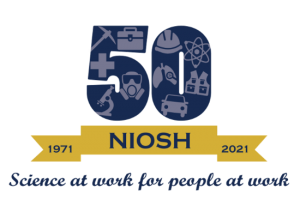Digital Version of the Impactful Revised NIOSH Lifting Equation Applications Manual Now Available
Posted on by
The NIOSH 50th anniversary is not the only one being celebrated this year; 2021 also marks the 40th anniversary of the publication of the original version of the NIOSH Lifting Equation (NLE) in 1981 and the 30th anniversary of the first presentation of the Revised NIOSH Lifting Equation (RNLE) in 1991. Publication of the RNLE generated substantial interest in the ergonomics research community. The lifting index, a risk estimate of the RNLE, has also been used extensively by occupational safety and health practitioners worldwide for assessing the risk of low back pain associated with two-handed manual lifting tasks
Recently, NIOSH published an updated version of the 1994 RNLE applications manual. The 2021 digital update includes corrections of typographical errors, improved graphics, and a new searchable and 508-compliant format.
Background
The RNLE applications manual was officially published in 1994 by NIOSH but is often referred to as the 1991 NLE or RNLE because it was first presented to the public at a national conference in 1991 [1]. The manual provides users of the RNLE, including occupational safety and health practitioners, with methods for accurately applying the RNLE for assessing the risk of low back pain associated with a variety of manual lifting tasks. Because many measurements and calculations are required for using the RNLE, NIOSH published a mobile app to help users calculate the lifting index.
Impact
Surveys have shown that certified professional ergonomists in the United States and many other English-speaking countries recognized the RNLE as the most popular ergonomic risk assessment tool. [2, 3] The RNLE applications manual and its accompanying research paper [4] continue to be important guidance documents for safe manual materials handling. The RNLE has significant impact on the ergonomics research community and working populations around the world. [5] It has served as the basis for standard setting including:
- The International Organization for Standardization (ISO) standard 11228-1 (manual handling: lifting, lowering, and carrying)
- The lifting portion of the US Department of Defense military human engineering design criteria standard 1472H
- Ergonomic Guidelines for Small Lot Delivery Operations published by the Automotive Industry Action Group and Society of Automobile Engineers
- Lifting guidelines on certain patient handling tasks for healthcare workers
- Lifting guidelines for pregnant workers
Additionally, many industry stakeholders adopted the RNLE as their workplace lifting guideline to protect workers from lifting-related musculoskeletal injuries. As a result of the wide application of the RNLE in assessing manual lifting tasks, many other lifting index metrics, such as the sequential lifting index, variable lifting index, and cumulative lifting index have been developed and validated by the research community. [6-10] The RNLE has been included in numerous ergonomic textbooks as a guide on how to assess lifting risks.
We anticipate the RNLE will continue serving workers and employers by contributing to the prevention of low back pain, which is a common and costly musculoskeletal health problem in the workplace. Be sure to download the newly updated RNLE applications manual.
Have you used the RNLE for your lifting risk assessments? Please let us know in the comments below and share your thoughts on future improvements for the RNLE.
Acknowledgements
The authors would like to acknowledge the significant contributions of the late Drs. Thomas R. Waters and Arun Garg to the development of the RNLE and their efforts to validate associated outcomes of the RNLE.
Jack Lu, PhD, CPE, is a Research Ergonomist in the Division of Field Studies and Engineering; and the Manager of the NIOSH Musculoskeletal Health Cross-Sector Program.
Asha Brogan, BA, is a ORISE Fellow in the NIOSH Division of Field Studies and Engineering.
Jennifer Tyrawski, PhD, is a Health Communications Specialist in the NIOSH Division of Field Studies and Engineering.
This blog is part of a series for the NIOSH 50th Anniversary. Stay up to date on how we’re celebrating NIOSH’s 50th Anniversary on our website.
References
- Garg, A. (1991). Biomechanical basis for manual lifting guidelines. National Technical Information Service: Scientific support documentation for the Revised NIOSH Lifting Equation (Technical Contract Report 115-175). Springfield, VA: National Institute for Occupational Safety and Health.
- Dempsey, P., McGorry, R. and Maynard, W. (2005): A survey of tools and methods used by certified professional ergonomists. Applied Ergonomics 26: 489-503.
- Lowe, B., Dempsey, P. and Jones, E (2019). Ergonomics assessment methods used by ergonomics professionals. Applied Ergonomics 81: 102882.
- Waters TR, Putz-Anderson V, Garg A, Fine LJ (1993) Revised NIOSH equation for the design and evaluation of manual lifting tasks. Ergonomics 36 (7):749-776
- Lu M., Putz-Anderson V., Garg A. and Davis K. (2016): Evaluation of the impact of the revised NIOSH lifting equation. Human Factors. 58 (5):667-82.
- Waters T., Lu M. and Occhipinti O. (2007): New procedure for assessing sequential manual lifting jobs using the revised NISOH lifting equation. Ergonomics 50 (11): 1761-1770.
- Waters, T., Occhipinti, E., Colombini, D., Alvarez-Casado, E., and Fox, R. (2015). Variable lifting index (VLI): A new method for evaluating variable lifting tasks. Human Factors 58 (5): 695-711.
- Battevi, N., Pandolfi, M. and Cortinovis, I. (2016): Variable Lifting Index for Manual-Lifting Risk Assessment: A Preliminary Validation Study. Human Factors 58 (5): 712-725.
- Garg, A. and Kapellusch, J (2016). The Cumulative Lifting Index (CULI) for the Revised NIOSH Lifting Equation: Quantifying Risk for Workers with Job Rotation. Human Factors 58 (5): 683-694
- Fox B., Lu M., Occhipinti E. and Jaeger M. (2019): Understanding outcome metrics of the revised NIOSH lifting equation. Applied Ergonomics 81: 102897.
Posted on by

